« Bhopan » : différence entre les versions
Page créée avec « 600px|sans_cadre|droite|alt=Bhopan vignette|alt=Bhopan Flag|Bhopan Flag 600px|sans_cadre|droite|alt=Bhopan 600px|sans_cadre|droite|alt=Bhopan map|Bhopan map 600px|sans_cadre|droite|alt=Bhopan For most of Golarion, Bhopan is at best a myth, a wild and unverified claim scrawled in the journals of explorers with questionable reputati... » |
|||
| Ligne 240 : | Ligne 240 : | ||
==GOVERNMENT== | ==GOVERNMENT== | ||
[[Fichier:Bhopan 08.jpg|600px|sans_cadre|droite|alt=Bhopan]] | |||
Bhopan is a hereditary monarchy, though its laws allow for transitions in rulership to people outside the royal bloodline under certain conditions. Any Bhopanese citizen can theoretically obtain a position as a courtier working to help administer the country’s logistics and politics; in practice, these positions tend to be held by a small number of families and retired Greenwatchers. | Bhopan is a hereditary monarchy, though its laws allow for transitions in rulership to people outside the royal bloodline under certain conditions. Any Bhopanese citizen can theoretically obtain a position as a courtier working to help administer the country’s logistics and politics; in practice, these positions tend to be held by a small number of families and retired Greenwatchers. | ||
Version du 23 juin 2024 à 23:16
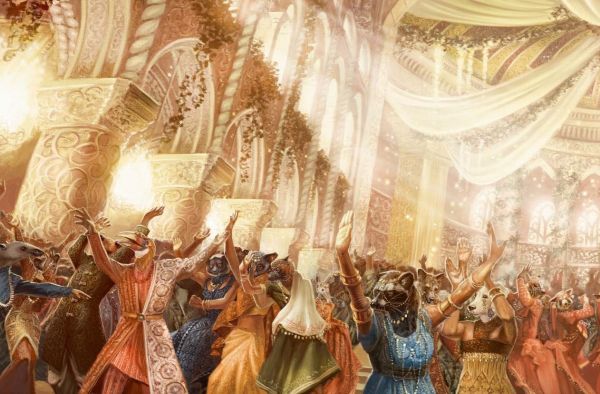
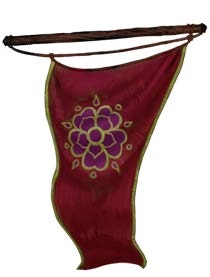
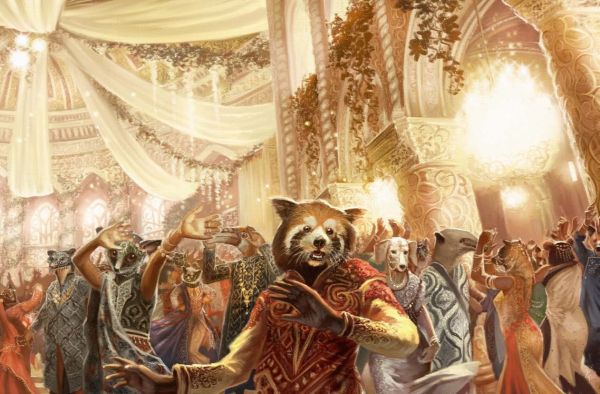
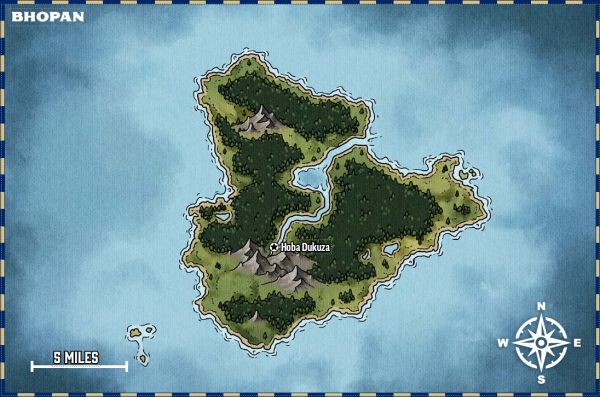
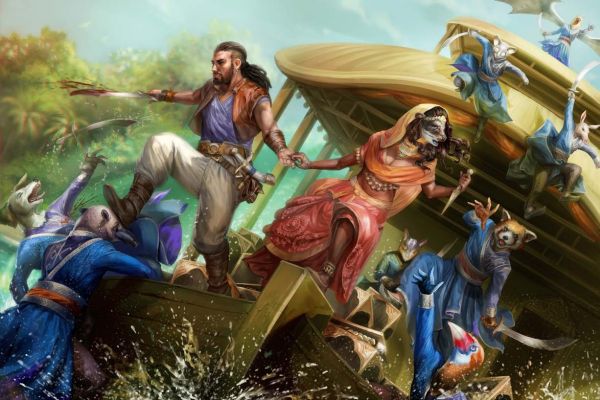
For most of Golarion, Bhopan is at best a myth, a wild and unverified claim scrawled in the journals of explorers with questionable reputations. Though the Pathfinder Society recently began publishing modern accounts of Bhopan and its people, the Bhopanese are insular and reclusive with no outside trading partners. They maintain strict social paradigms that discourage their small population from traveling beyond the island nation’s confines.
Long ago, a First World creature known as Qxal the Thorned Monarch established a demiplane of fey magic, making it their stronghold from which to terrorize the surrounding lands. They focused their wrath on the ancient empire of Bhopan, nearly destroying its civilization entirely, before being bested by a group of Bhopanese heroes who managed to wrest away the artifact Qxal had created to focus the power of their demiplane: the Perennial Crown. Without the crown, the Thorned Monarch lost the ability to control much of their own power, leaving it bound within the realm beyond the Door of Seasons. What remained of the Bhopanese people retreated to isolation on the last and furthest island they had occupied, where they locked the crown away.
For years, the rest of the world believed Bhopan to be nothing more than one of many ancient empires lost to time and disaster, if they knew enough of Bhopan to believe anything at all. Then one day, in the depths of the Mwangi Expanse near the original capital of Bhopan, four of the founding members of the Pathfinder Society came upon a mysterious gateway covered in locks and surrounded by keys: the Door of Seasons. As the Pathfinders tried each of the keys without success, Qxal’s mocking voice told them any of the keys could open the door if the right conditions were met; namely, since the four discoverers found the gate at the same time, it wouldn’t open for any of the four until only one of them remained alive.
The Pathfinders resisted Qxal’s attempts to manipulate them into killing each other. Instead, they swore a pact to ignore the door, leaving it to whichever of them happened to live the longest. This came to be known as the Open Road Pact—the foundation for the strong ethos of cooperation that has served as one of the Pathfinder Society’s guiding principles. If those Pathfinders had been equally strong-willed, Bhopan might still be hidden away from the rest of the world to this day, but such was not the case.
Selmius Foster (N human male Pathfinder) couldn’t shake the belief that whatever lay behind the Door of Seasons must be a treasure of immeasurable worth, and he continued to research the history of Bhopan alongside his student and steward, Adolphus (N human male Pathfinder). They scoured ancient ruins across the Mwangi Expanse, eventually collecting enough clues to realize Bhopan wasn’t completely destroyed and that its people still lived, hidden on an isle in the Obari Ocean.
Selmius and Adolphus gathered an expedition and found Bhopan once more. The Bhopanese people didn’t particularly welcome their discovery, however, as the islanders feared any contact with the outside world would reveal their location to the Thorned Monarch and bring ruin upon them once more. While Selmius and Adolphus found an ally in the revolutionary Bhopanese princess Ganjay, their expedition ultimately ended badly. Selmius was executed for high crimes against the Bhopanese people, while Adolphus and Ganjay fled the island just steps ahead of their own execution orders.
Adolphus and Ganjay settled down in the Garundi nation of Nex, where they eventually founded their own Pathfinder lodge, Nexus House. For generations, the secret of Bhopan was forgotten yet again, until a new generation of Pathfinders found Adolphus and Ganjay’s lost records and mounted a new expedition to Bhopan. Sadly, the Pathfinders brought forth the very evil the people of Bhopan had always feared when the Bhopanese vizier manipulated them into claiming the Perennial Crown for themselves.
Though the Pathfinder Society ultimately defeated Qxal, the people of Bhopan knew they could no longer remain hidden. Bhopan’s current ruler, King Webhekiz (LN male fey-touched human aristocrat) is quietly building ships and training soldiers, sailors, and diplomats tasked with helping Bhopan find its place in a world that has largely forgotten its existence.[1]
GEOGRAPHY
Bhopan is a tiny island lying amid pockets of doldrums between two major currents of the Obari Ocean. As such, it’s almost impossible to arrive at Bhopan accidentally. A ship needs a captain who knows how to navigate the unstable seas and a navigator who knows where to go, lest they end up stranded in still, windless waters or hurled against an unseen reef. These deterrents are exactly why the Bhopanese chose it as the final bastion for their people.
Bhopan’s coastline is constantly shrouded in oceanic mists that also conceal many jagged stone reefs. Thin, gravelly beaches give way almost immediately to rich, red earth and towering, primeval jungle trees. There’s very little driftwood on Bhopan’s gravel beaches; the trees are powerful, stubborn, and release their branches only rarely. Moreover, the island’s inaccessible position between ocean currents means the chances of driftwood floating to the island from anywhere else are virtually nonexistent, which might seem inconsequential, but it’s one of Bhopan’s more deadly characteristics. No driftwood means no firewood or scrap wood for temporary shelters, forcing stranded sailors and Bhopanese scouts separated from their squads to either spend the night on the barren coastline or risk the deadly shadows beneath the forest boughs at night. Both options generally prove fatal, though many Bhopanese scouts have a small bit of fey magic at their command (either through a sorcerer bloodline or the Fey Influence line of feats on page 126) to help them claim a slightly better chance at survival.
Fed by First World magic and ancient blood rites, the Bhopanese jungles are forbidding by any standard, featuring deadly types of plant life not found anywhere else. Stretching from coast to coast except for pathways carved by Bhopan’s scouts—known as Greenwatchers—and a safe zone around the capital city, these jungles are a more reliable defense for the Bhopanese people than many nations’ militaries, though no citizen of Bhopan would be so foolish as to brave their perils alone.
HOBA DUKUZA SETTLEMENT 12
N CITY-STATE
Government monarchy
Population 1,017 (50% fey-touched humans, 47% beastkin, 3% other)
Languages Bhopanese, Kelesh, Mwangi
Religions Agnosticism, Desna, Green Faith, Shamanism
Threats ancient curses, fey, natural hazards
Favorite Food: Bhopan’s capital and only city, Hoba Dukuza, is home to one of the oldest and longest operating bakeries on Golarion. While any kind of baked good can be purchased there, local favorites are delicious layer cakes made with vanilla extract and jungle fruit.
Dalila Bhotphtha (NG female fey-touched beastkin human baker 6) proprietor of Bhotphtha Bakery
King Webhekiz (LN male fey-touched human aristocrat 6) king of Bhopan Tannik Vey (LG female fey-touched human scout 10) leader of the Greenwatch
Vizier Lelzeshin (LE male fey-touched human ghost 7) recently deceased vizier of Bhopan (position currently open)[1]
OUTER JUNGLE
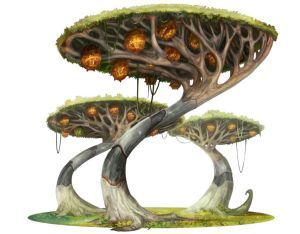
Bhopan’s outer jungle, the region of particularly dense forest that hides the pathways to the capital city of Bhopan proper, is home to a wide variety of malicious fey. These fey include all manner of gremlins (Bestiary 192), bilokos (Pathfinder Lost Omens: The Mwangi Expanse 294), and dryads (Bestiary 246). Some of these creatures are allied with the Bhopanese people. Others are stranded servants of Qxal, eager to prey on anyone who encroaches on territory they’ve claimed.
A staggering array of natural and fey-made hazards appear in the outer jungle, from simple pitfalls designed to hold living prey for fey who prefer their meals and victims relatively fresh, to deadly giant flytrap plants that devour their victims nearly as efficiently as the gelatinous oozes that also lurk beneath the jungle canopy. The number of ways for the unwary to die in Bhopan is remarkable due to the unlikelihood of so many threats existing in balance in such a small area.
SHRAPNEL TREE GROVES
Shrapnel tree groves are one of Bhopan’s deadliest natural features, particularly for interlopers without a Bhopanese guide. Shrapnel trees are a variety of palm tree bearing a dense, pumpkin-like fruit. When fully ripe, these fruits fall from the tree, exploding when they hit the ground and sending shards of woody shrapnel and razor-edged thorns flying in all directions.
Each thorn carries a shrapnel tree seed. These seeds require a significant amount of protein, calcium, and a variety of other fluids and minerals to sprout, most of which can be found in the bodies of flesh-and-blood creatures. As a result, virtually every shrapnel tree also serves as a grave marker for an unfortunate creature slain by a shrapnel tree thorn.
Ancient And Storied
Surrounded by water and hidden from view by mangrove and palm trees, Hoba Dukuza is Bhopan’s capital and only city, although barely a city by the standards of the great nations of the Inner Sea. Hoba Dukuza’s people and culture are nonetheless steeped in traditions of aristocracy influenced by fey customs and magic. Hoba Dukuza sits atop a massive freshwater spring that feeds a large lake before flowing from the island’s heart to the ocean. This reservoir is likely the reason the Bhopanese settled on the island in the first place. Some hidden magic linking it to the First World—or perhaps the Plane of Water—prevents it from ever running dry.[1]
A DAY IN BHOPAN
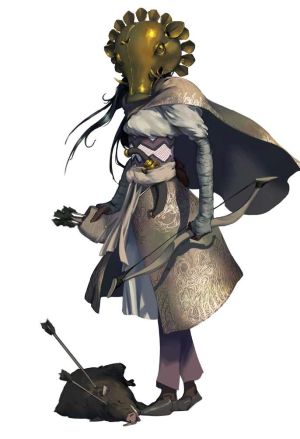
The people of Bhopan have cultural roots both from the ancient empires of Garund and the fey courts of the First World, a fact that’s apparent in both their appearances and daily activities. Though primarily human, Bhopan’s people almost all bear some amount of fey blood or magic. These fey influences often provide particular gifts to the Bhopanese citizens, helping to determine their place in society and their role in the community.
Bhopanese who bear dryad influences are often gardeners or herbalists, while those with gremlin influences hold favorable positions as scouts or barristers. These are generalities, however. While certain families, bloodlines, and influences might predispose a Bhopanese person to a particular societal role, most Bhopanese outside the royal family are free to spend their days as they please, as long as they don’t take more from the community than they receive.
Sunrises in Bhopan are typically greeted by a quiet city, filled with the smell of baking bread and fried plantains. Bhopan’s people aren’t strictly vegetarians, but meat is rarely consumed within the city, and domesticated animals aren’t kept for food. That fact, along with the generally deadly nature of the surrounding jungle, means not even a rooster’s crow is likely to break the quiet reverie of early morning. Bhopanese bakers ready their shops and stalls for the bustle of the coming day, while weary scouts and guards retire from their nightly duties, entrusting the next shift to continue keeping Bhopan’s citizens safe.
Morning in Bhopan truly begins when the sun crests above the mangrove trees, lighting every corner of the city. Farriers care for the city’s steeds and mounts, which run the gamut from a small handful of royal horses whose bloodlines stretch to Ancient Osirion to enormous millipedes whose carapaces are carved to accommodate saddles or palanquins. Children leave their homes to play with their friends until the storytellers and historians who serve as the city’s teachers settle into favored spots and gather the children for lessons.
By the time the sun is high in the sky, the people’s routines are well underway. Having expended their energy chasing each other through the city streets, or using palm fronds to tickle millipedes loaded with supplies for the castle, children settle down with snacks to listen to the scholars. Some children have a favorite historian or storyteller to whom they flock each day, while others make a point of listening to a different scholar at each opportunity. The afternoon is also the appointed time for a royal procession through the city. Bhopanese culture holds that a good ruler must be known on sight to each citizen, so a member of the royal family takes a daily palanquin trip around the city, passing out favors and listening to the concerns and desires of the people.
As the sun sets below the mangroves, the city returns to the peaceful calm of the night. Scouts from the Greenwatch return from their shifts that began with the dawn, and guards on the day shift return to their families while their peers on the night shift—typically Bhopanese whose fey magic allows them to see in the dark or create magical light—resume their duties. The historians and storytellers, voices hoarse from exercising their craft, are replaced by bards whose soothing sonnets sing the sun to sleep and welcome the night. Bonfires are lit around the city’s perimeter, keeping the antagonistic fey who make their homes in the jungle at bay and ensuring the ever-growing jungle doesn’t claim any of the cleared territory around the city’s border.
As the last notes of the bard’s songs shimmer into nothingness along with the sun’s light, a heavy pall settles over the city. The people of Bhopan know that to be rowdy when the sun is gone is to invite the attention of dangerous fey creatures whose magic or skill is too much for the Greenwatch to counter. The peaceful lives they live are won through wisdom and discipline, firmly enforced by centuries-old tradition.
Bebinca
(Layered Dessert)
This rich cake is considered luxurious not just for the taste but the skill and effort required to make it. Bakers outside of Bhopan’s famous Bhotphtha family often wind up with a lopsided mess instead of a dessert.
2 cups coconut milk
1 cup coconut cream
1 1/2 cup sugar
24 large egg yolks
2 cups all-purpose flour
1 1/2 cups ghee, or clarified butter
1 teaspoon vanilla extract
2 tablespoons nutmeg powder
Mix the coconut milk, coconut cream, flour, sugar, nutmeg, vanilla extract, and the egg yolks and make a batter. Grease an oven proof dish with a spoonful of melted butter. Take the pan out of the oven and pour in enough of the prepared batter to form a 1/4-inch-thick layer. Put the pan back in the oven and cook until the top is golden or golden brown, watching carefully. Immediately spread another spoonful of butter and pour another 1/4-inch-thick layer of batter over the first layer and spread evenly. Bake and repeat this until all the batter is used up, making sure to save butter for the top layer. Turn out the bebinca onto a wire rack. Garnish with sliced almonds if desired. Cool and cut into slices before serving.[1]
A YEAR IN BHOPAN
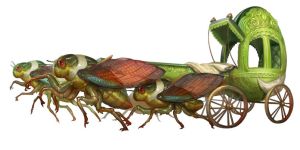
The people of Bhopan have an intense reverence of the natural cycle, particularly as embodied by the passing of seasons. Despite its position so close to Golarion’s equator, Bhopan has an unusually regular and evenly divided seasonal cycle through spring, summer, autumn, and winter. Pathfinders who have visited the island speculate this might have something to do with the fey or First World influences on the island. The Bhopanese think little of it; the island of Bhopan has been their home for so long that they know its quirks and rhythms intimately, with little need to wonder about why, when the what and where are clearly understood. Bhopan’s people reflect each of its seasons in their attitudes, traditions, and clothing. They flow from one fashion to the next with the same easy fluidity as the seasonal procession itself.
Spring in Bhopan, as in many places, is a time of joy and renewal as the Bhopanese citizens celebrate the death of winter. For Bhopan’s people, this celebration is perhaps a bit more deeply heartfelt than in other areas since spring also means a host of cold-weather fey predators become quiescent for a time. Festive floral arrangements from early blooming flowers and plants are common during this time, as are outdoor dances and competitions of skill. The Greenwatch seeks out new recruits, often garnered from the finalists in competitions of archery, foot races, and spear handling. People of all genders in Bhopan dress in bright colors and favor styles in soft, flowing cuts. Due to occasional brief, but intense, tropical storms, waterproof footwear that covers the ankle and calf is typically preferred. Practicality rarely trumps style for Bhopanese citizens, though, and boots are generally dyed in spring colors that match or complement the rest of their attire.
Bhopanese summers are times of industry and production. Longer days and shorter nights mean even those on the night watch get at least a few daylit hours with friends and family. The summer fey who haunt the outer forest, while no less dangerous than their winter kin, tend to be less directly aggressive. Occasionally, dryad queens and other fey who fancy themselves aristocrats send trade delegations to the city, offering rare seeds and gifts of living wood in exchange for the services of Bhopanese bakers and tailors. Royal processions are curtailed during this time to ensure the royal family is available to greet visiting dignitaries, though such occasions don’t mean the royal family has less contact with citizens. Contact instead largely comes via elaborate balls and court dances held in the royal palace. Invitations to such balls are structured to ensure all adult citizens can attend at least one a month, though balls held as receptions for visiting dignitaries are typically limited to the royal family, their courtiers and aides, and a few prominent citizens.
Autumn in Bhopan isn’t unlike the spring, though the greens, purples, and blues of spring plants and flowers are replaced by shades of red and gold. Bhopanese fashions reflect the colors of the flowers and trees, not just in the color schemes but also in the patterns of clothing. Scouts and guards recruited during the spring often begin their first duty shifts around this time, accompanied by their more experienced peers and superiors. While this period is generally a time of joy and celebration as young adults take their place in the community, it can also be a time of sadness. Every summer, at least one young scout whose skill, training, or experience was insufficient to the trials before them passes, slain by one of the many dangers lurking in the outer forest.
Winter is a time of quiet contemplation for Bhopan’s residents. With the falling of the first snows, the dangers of the surrounding forest are enhanced: pit traps and the like become harder to detect, and many dangerous fey monsters who slumber through the warm months awaken with a fierce hunger. During this time, the only music allowed outdoors are sonorous dirges invoking deities and ideals that First World creatures find uncomfortable or annoying; joyful sounds that might attract a sadistic boogeyman or snow monster are banned for the safety of all involved.
Fey Influence
The people of Bhopan almost universally have some degree of fey magic passed down through family bloodlines. Some of this magic is represented by the Fey Influence feats presented on page 126. While the people of Bhopan are almost all descended from the humans who fled Garund centuries ago, many of them are no longer recognizably human, at least not to people outside Bhopan.[1]
PEOPLE OF BHOPAN
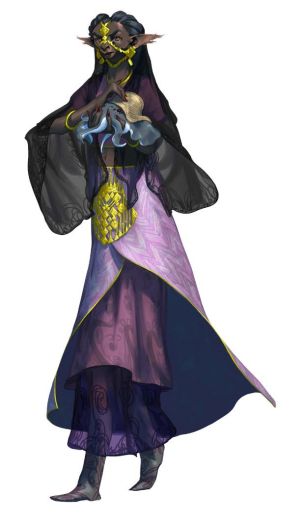
Bhopan’s people emigrated to the isle of Bhopan from the Mwangi Expanse many centuries ago. In the time since, they’ve developed their unique clothing styles, specialized armors, and other industries as well as evolved into entirely new ancestral heritages. The fey influence on their bloodlines that caused these evolutions extends back to before the Bhopanese exodus from Garund, though it has grown significantly in the generations since. Bhopan is home to a variety of humans, beastkin (Ancestry Guide 78), and a handful of friendly fey.
Bhopan’s people have average human lifespans, though they generally tend to have children at a much slower and more irregular rate than humans in other areas, with some specific beastkin families existing as notable exceptions. Whether a quirk of biology or the influence of the magic that suffuses the entire island, the population of Hoba Dukuza never seems to grow too large for the city to shelter or shrink so much that it becomes a hardship.
Bhopanese clothing primarily uses silks and plant-based textiles as a base. Greenwatchers harvest silk from spiders occupying the outer forest; occasionally, leaders of fey clans trade silk for other goods. Additional textiles are woven varieties of local plant life, with each tailor having their own particular weaves and blends. Bhopan also features an array of highly skilled dye mixers who have learned how to best use the natural resources of the island to create a dizzying array of bright colors. Bhopanese dyes are made from rare jungle flowers and heavily favor reds and blues. Purple dyes are highly prized though typically reserved for the wealthiest or most esteemed Bhopanese. Purple dye can be made only in small quantities using an extract harvested from a type of sea snail that can be found occasionally in tidal pools along Bhopan’s coast.
Bhopanese styles are somewhat eclectic, fusing ancient Garundi styles filtered through scores of generations of tailors. Other influences include the basic necessities of living on a tropical island that still experiences winters more appropriate for northern climes and the preferred styles of Bhopan’s fey neighbors. Robes, wraps, capes, and other versatile items of clothing are extremely popular, as are colorful dyes and fringes. The leaf-weave armor made by Bhopanese tailors is some of the finest on Golarion, made so by a combination of time and necessity. Members of the Hoba Dukuza guard and the Greenwatch require protection strong enough to resist the blades, claws, and fangs of the hostile fey and natural creatures that surround them, but armor must still be light enough that it encumber them while they sneak through the woods or make a hasty retreat. Earning a commission to craft leaf-weave armor for the Greenwatch is considered one of the highest honors a tailor can achieve in Hoba Dukuza, second only to being selected as personal tailor for the royal family.
Bhopan’s industries are largely localized, with the majority of its extremely limited trade occurring with the fey who share their island. Forest and water fey trade baskets of sweet sap, rare plants and fungi, and underwater salvage to the bakers and tailors in Hoba Dukuza for baked bread, luxurious pastries, and elegant garments. Even Bhopan’s gremlins and bilokos sometimes venture into the city to buy and sell, holding a red flower as a signal of their peaceful intentions. Few Bhopanese enjoy working with such unsavory customers, which means the vicious fey rarely visit without something of extreme interest, something that can attract even the most recalcitrant buyers.

Recently renewed contact with the Pathfinder Society injected a small but significant source of outside goods into Bhopan’s market. So far, most Bhopanese purchase such things due to curiosity rather than need, but the slow simmer of a new cultural movement can be felt throughout Hoba Dukuza. With King Webhekiz’s plans to extend Bhopan’s reach via a new royal navy, foreign navigational instruments are in vogue among ambitious young Bhopanese. Despite a history of animosity with the Pathfinder Society that was only recently assuaged, Bhopanese high society has become somewhat obsessed with wayfinders. Though the Pathfinder Society doesn’t offer these unique compasses to non-members, counterfeit wayfinders have sprung up in some local shops, and a few extremely wealthy Bhopanese have managed to obtain genuine articles from fey contacts.
Most of the people of Bhopan are agnostic, recognizing the existence of gods but holding no particular attachment to them. The heavy presence of fey has left many Bhopanese more interested in concrete actions that produce immediate results, rather than ephemeral mysteries of most mainline churches. The tyranny of Qxal left deep scars, and no Bhopanese would willingly call on or even mention the Eldest of the fey. Many are willing to take on a dryad as a house god of sorts, however, performing small tasks to please their patron and receiving minor gifts in return. A handful of families maintain their worship of Desna, believing the goddess of travelers watched over the Bhopanese people as they fled Garund. Druids and rangers serving in the Greenwatch occasionally worship the Green Faith.
Shamanism is widely practiced by many Bhopanese families, though each family tends toward its own practices and rituals. Bhopanese families who practice shamanic traditions often have a patron spirit on whom they rely for guidance and protection. Some of these spirits are entities who existed on the island before the Bhopanese exodus, while others were brought from Garund. The nature of these spirits varies extremely, from minor household spirits whose presence can be truly confirmed only by a shaman attuned to their presence, to powerful eidolons who serve as minor deities protecting an allied family and bonding to a new summoner generation after generation. Bhopanese historians and storytellers occasionally teach, “If a person speaks to what is not there and moves what they do not touch, they are a shaman. If they walk in the shadow of a god that all can see, bow politely and find somewhere else to be.” Despite this belief, worship of said eidolons is common, and any summoner who commands one of these impressive creatures can expect a cult of sorts to quickly spring up around them.
Ancient Bhopanese tradition states any member of the royal family who displays the aptitude to become a summoner and bonds with an eidolon must forswear all rights to the throne of Bhopan. The commonly accepted reason for this tradition is that a summoner is bound to the interests of their eidolon, while the ruler of Bhopan must be someone who can place the people’s interests above all others. This particular tradition isn’t one that was brought to the island from Garund; in all likelihood, the tradition’s roots are tied to concerns about the influence of Qxal and other powerful fey who have sought to conquer, subvert, or destroy Bhopan.
Bhopanese Lineages
The influences of First World magic and powerful fey entities, combined with a number of specific pacts and rituals inserted into Bhopanese society by Qxal, resulted in many Bhopanese families evolving into distinctly recognizable varieties of beastkin. While certain beastkin variants appear across multiple generations, it isn’t uncommon for entirely new types of beastkin to arise in a Bhopanese family. Such births are generally seen as heralds of good luck for the family, though certain animalistic characteristics, particularly reptilian features that might be reminiscent of adversarial bilokos who inhabit the island’s outer forest, might be viewed with less enthusiasm.
Most notable among beastkin families are the tenric beastkin who form the Bhotphtha family and their immediate cousins as well as several families of dhole beastkin who were among the first beastkin to develop on the island. Today, Bhopan is home to beastkin resembling almost every type of animal on the island and even a few animals uncommon to the entire region.
Honorary Titles
Some fey officially join Bhopanese society or interact with it often enough for them to gain tacit membership. These individuals are granted the honorific of “Kajati” before their given names. [1]
CULTURE
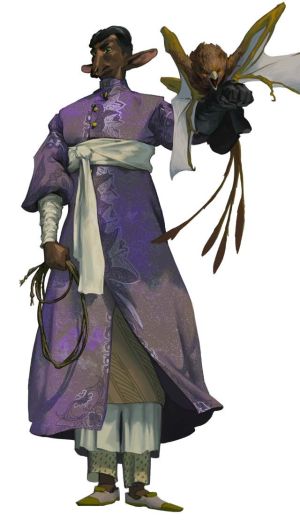
Bhopan has a rich culture shaped by the history of its ancient empire, the influences of fey allies and enemies, and the unique environment of its island home. Bhopan’s cultural hallmarks include lavish theater productions and robust storytelling traditions. Martial traditions are largely focused around the Greenwatch scouts who patrol the outer forest.Since time immemorial, Bhopan’s royal family has maintained a wing of the castle dedicated to housing artists, historians, and storytellers whose only responsibilities are to pursue their work and share their creations with the rest of Bhopan. Bhopanese artists who create physical goods, such as sculptors, painters, and potters, prefer to work in mediums that are either practical or biodegradable. Temporary art or art that performs a vital function is valued highly, while wasteful permanent fixtures like statues made of precious metal are generally seen as gauche or even obscene.
Bhopan’s buildings are the one exception. Every permanent structure is considered a work of art, whether a simple family home or a lavish theater. Hoba Dukuza features several beautiful theaters that each offer their own kind of experience, such as balcony seating made from living trees or glass-bottomed boats that circle the Lake of Tears throughout the performance.
Perhaps the most revered art form in Hoba Dukuza is the art of storytelling. On any given day, storytellers ply their trade on street corners or in public gathering places like amphitheaters and taverns, recounting stories old and new. These storytellers serve as one arm of the informal Bhopanese education system, sharing the people’s morals and culture, while historians trained in the royal home serve as the other arm, teaching children and adults alike the history of Bhopan, stretching back to the ancient empire. Historians and storytellers share common areas, and while their roles and duties are distinct, it isn’t uncommon for an individual to tell a fable one day and present a true, historical event the next. Likely attributable to their many fey connections, Bhopan’s people are less concerned with whether a story or event actually happened as they are with whether that story is told well and in a way that conveys something of moral value.
Over the centuries, several distinct storytelling traditions have gained prominence in the city, though three are particularly notable and widely practiced.
The gon-ra plays involve a single storyteller acting out several distinct parts in a one-person performance, under highly restricted conditions where props and non-acting-related gimmicks are generally frowned upon. These performances are the preferred method for relaying religious or moral allegories.
Rhythm speeches are extended monologues preconstructed, or occasionally improvised, to tell a specific story, usually historical in nature. While not songs in the traditional sense, these speeches use a combination of measured sentence lengths and rhyming syllables to draw listeners into the story and keep them engaged. These performances are the preferred method for teaching Bhopan’s history.
The third practice is fireside storytelling. These stories typically don’t have any props, similar to gon-ra plays, but give the storyteller significant leeway in how they use their voice, body posture, and personal expressions to relay their tale. Beloved by children but seen as a somewhat unreliable narrative device by adults, fireside storytelling is largely reserved for fictional tales of heroes and monsters.[1]
GREENWATCH
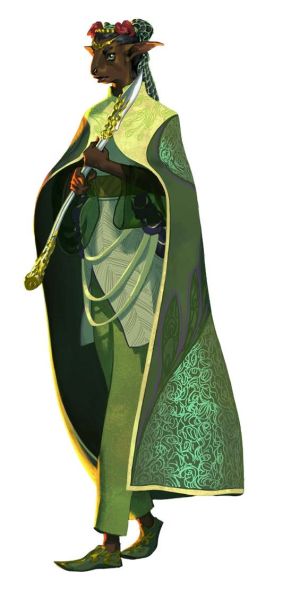
Bhopan’s elite scouting unit is called the Greenwatch. Members of the Greenwatch, or Greenwatchers, are handpicked by veteran members of the organization, though enlistment is entirely voluntary. Experienced Greenwatchers know the dangers of the outer forest require scouts with the skills and temperament to remain focused and reliable regardless of the circumstances. As such, forced conscription is almost anathema to Greenwatchers, most of whom would be terrified to learn the person watching their back was there against their will.
Greenwatchers have the highest mortality rate of any profession in Bhopan, which gives them a position of respect bordering on reverence within Hoba Dukuza. Every Greenwatcher knows their first day on the job and any day thereafter could be their last. Greenwatchers who survive long enough to become too old to fulfill their duties are given positions as honored courtiers if they wish to continue their service or are provided with lavish pensions if they choose to retire. In many cases, the pensions are mostly symbolic; it’s standing custom among all the shopkeepers of Hoba Dukuza to never charge active-duty or veteran Greenwatchers for services rendered. Many of the richest and most powerful families in Hoba Dukuza are those with long family histories of service in the Greenwatch.
First Watch
A Greenwatch recruit’s first solo mission marks their full initiation into the Greenwatch, and it’s a somber affair, as the scout might not return. Before they depart, the recruit kneels and is given a cloak and a ceremonial crown of flowers by the captain of the Greenwatch. Should the scout return, they once again kneel and are granted an accolade with a ceremonial weapon that has been quenched in purified lake water and polished with precious oils.[1]
CITY LOCATIONS
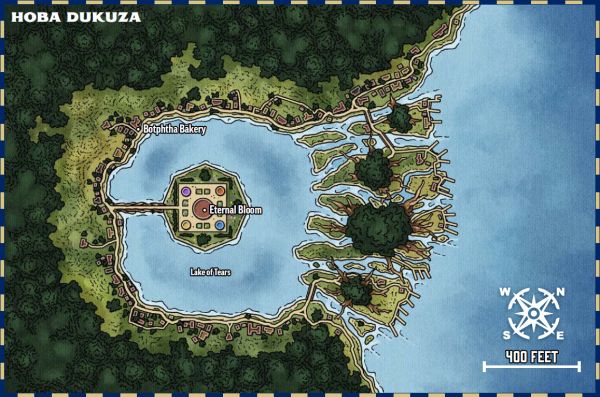
Hoba Dukuza, meaning “safe refuge” in the Bhopanese language, is the capital and only city of Bhopan. All Bhopanese history and culture is contained within this single small city of about a thousand people.
BHOTPHTHA BAKERY
The largest and oldest of Hoba Dukuza’s bakeries, Bhotphtha Bakery offers almost every baked good imaginable, from unleavened bread to opulent, seven-tiered wedding cakes. The main entrance for Bhotphtha Bakery is a pair of paneled doors tall enough to easily accommodate an ogre, opening into a spacious round reception area. Glass display cases filled with countless examples of available baked goods cover the walls of the reception area. An enormous wooden counter, at which a half-dozen clerks take customers’ orders and retrieve goods from the kitchen, blocks access to the ovens and kitchen areas in the back.
The proprietor of Bhotphtha’s Bakery is Dalila Bhotphtha (page 123), whose family has owned and operated the bakery for all of Hoba Dukuza’s recorded history. Dalila is approaching 80 years old but is too in love with her work to retire and allow one of her many children to take over. She proudly tells anyone who cares to listen that she personally baked and decorated the wedding cakes of every married couple in Bhopan, including three dryad queens from the outer forest. Dalila is far too beloved by her customers for anyone to question her claim.
ETERNAL BLOOM
The palace at the heart of Hoba Dukuza, Eternal Bloom is an immediate testament to the Bhopanese people’s attunement to nature and the fey influences that mark their culture. A square, vine-covered structure made of stone and living wood, Eternal Bloom has a tall tower at each corner, marking the cardinal directions. Each tower is topped with an enormous, living rosebud, each a different color.
The south tower is topped by a yellow rosebud, representing spring, hope, and the dawning sun. The east tower is topped by a purple bud, representing summer, royalty, and power. The tower marking the northern corner of Eternal Bloom is burgundy, representing autumn, the blood of the Bhopanese people spilled during their exodus from Garund, and defiance of the coming winter. The final tower on the western corner is blue, representing winter and death but also the continuity of life.
During important political events, elaborate ballroom dances are held within Eternal Bloom, with the complex and strictly codified steps of each dance taking the dancers from tower to tower in an elegant display intended to mirror the transitions from one season to the next.
LAKE OF TEARS
Eternal Bloom sits in the center of a crystalline lake fed by a freshwater spring. The source of the spring lies somewhere beneath the island’s surface, bubbling up to fill the lake before cascading to the ocean in a gentle river. The waters of the Lake of Tears are sweet, refreshing, and so clear that on a sunny day, someone sitting still in a boat can see all the way to the sandy lake bed.
The Lake of Tears takes its name from a speech given by the last empress of Bhopan shortly after she and the last survivors of the Bhopanese empire retreated to the island. She ended her final address to the people with the statement, “And though we make our final safe refuge here, upon this lake of tears, let none of us forget what was, or what can be again. Like springtime or a perennial flower, we do not come here to die, but rather to sleep and be reborn when the hard winter has passed.”
Ancient records state several years later, the empress drowned in the lake, though her body was never recovered. Bard songs and prophecies propose a different story, stating the empress swam down to the lake bed and beyond, eventually reaching the heart of the freshwater spring. According to these legends, the queen laid her scepter and robe there before passing through the spring to a new realm beyond. Supposedly one day, a new empress will be born “bearing the heart of Bhopan.” When she swims to the spring’s heart and reclaims the robe and scepter, the ancient empire of Bhopan will be made anew in a world safe from the monsters that brought the empire to the brink of extinction so long ago.
Bhotphtha Offerings
Bhopan’s unique cakes and confectioneries are one of the items most attractive to foreigners—a minor conundrum for King Webhekiz, as the sweets hardly ship well and thus make poor trade goods! The following are some of the most popular Bhotphtha bakery items.
Bebinca, a multi-layered cake baked in a clay oven with a fire fueled by coconut husks. Made with coconut milk, eggs, and ghee, this dessert is sometimes called the Queen of Cakes.
Bhotphtha Nut Cake, a heavy cake made with lots of egg yolks, a splash of rum, and a healthy smattering of cashews, walnuts, and almonds.
Baath Cake, made with semolina, fresh coconut, and rose essence, and then baked in a clay oven to perfection.
Honey Cake, an eggless confectionery iced with jam and sprinkled with flakes of dessicated coconut.
Black Plum Cake, a rich fruit cake made with slightly burnt caramel to give it a distinctive taste and color.[1]
GOVERNMENT
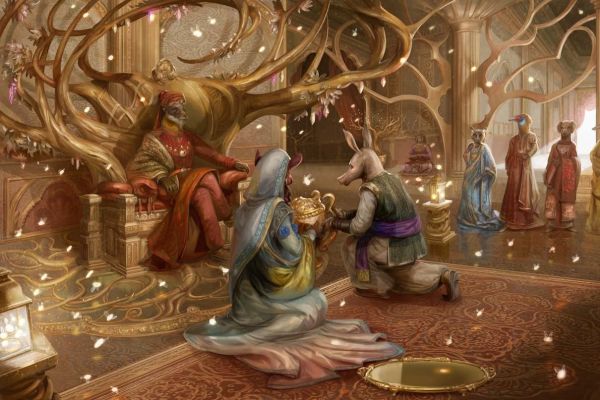
Bhopan is a hereditary monarchy, though its laws allow for transitions in rulership to people outside the royal bloodline under certain conditions. Any Bhopanese citizen can theoretically obtain a position as a courtier working to help administer the country’s logistics and politics; in practice, these positions tend to be held by a small number of families and retired Greenwatchers.
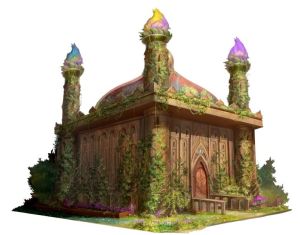
Bhopan’s royal family traces its lineage to long before the ancient Bhopanese empire crumbled, with extensive documentation of patents of nobility and detailed recordings of the entire family tree that occupy an entire room in Eternal Bloom. Each monarch of Bhopan had details of their rule cataloged in extensive histories that fill multiple rooms and dozens of bookcases. For the most part, these tomes are incredibly dry, boring affairs bearing remarkable similarities to each other. The most valuable tomes date before the exodus from Garund and are kept in sealed glass cases. These tomes are handled only with express permission from the royal family and the assistance of a royal archivist.
Bhopan’s royal family seems to be influenced by the same magic as the rest of the island—or at least some particular magic. Twins are never born to a sitting ruler, and no Bhopanese ruler has ever died without an heir. When Selmius Foster landed on Bhopan’s shores over four centuries ago, the heir-apparent Princess Ganjay fled the island with her lover, Adolphus. Within a month of her leaving, her mother and father discovered they were expecting a child, despite being well past childbearing years. Ganjay’s sister was born hale and hearty, and the line of succession continued undeterred.
Over the years, the position of king or queen of Bhopan became something of a ceremonial position. Leadership of the Greenwatch is decided by contests of skill or a standing vote by its members if a competition fails to provide a clear champion. The city guard is staffed by volunteers, and by tradition, its leader is selected by and answerable to the ruler’s chosen vizier. With little change and no reason to look far beyond its borders, Bhopan has been a land locked in time, demanding little of its rulers save that they keep the people happy and make regular appearances so that all their subjects know them on sight.
The current king, Webhekiz, was somewhat indolent and ineffectual for most of his rule, reveling in parties and doing little real work, secure in the competence of his clever vizier and keen-eyed captain of the Greenwatch. Recent disasters have shaken him from his lifelong fugue, and now Webhekiz seeks to redefine his role. While he has been neither particularly competent nor particularly savvy in his dealings to date, Webhekiz seeks to find the strength to lift his people onto the world stage once more. He hopes his rule will mark a new age of prosperity and growth for the Bhopanese that will result in new trade relations with neighboring countries and organizations like the Pathfinder Society. He fears that if he proves insufficient to the task, he might very well be the last monarch of Bhopan.
The tradition of appointing a royal vizier stretches to the days of Bhopan’s empire in Garund and has been observed to one extent or another by every generation of Bhopanese royalty since. The exact responsibilities of a vizier vary depending on the ruler. During periods of especially strong and competent leadership from the royal family, the position of vizier is typically an administrative one, serving as the ruler’s right hand and ensuring their will is executed according to their desires.
A strange fey magic comes with being appointed vizier of Bhopan. It’s said Bhopan’s viziers can see the future through mirrors and reflective surfaces, gaining visions of what is and what might be. Some of the oldest writings and histories of Bhopan speak of mighty viziers who could step into a mirror in Bhopan and step through another mirror on the other side of the world or even pull their own reflections from a mirror to fight alongside them. Though not specifically recorded in any physical document, there are many allusions to the idea that viziers from Bhopan’s early days might have also served as assassins for their rulers.
Theoretically, the same oath that grants a vizier their power and authority also makes it impossible for them to bring direct harm to a member of the royal family. In practice, it’s entirely possible for a clever vizier to work around their oaths as long as they don’t directly raise a hand against the royal family or use their powers to knowingly cause harm to Bhopan. Over the centuries, some viziers have protected Bhopan quietly from the shadows, serving their monarchs to the best of their abilities in whatever manner they see fit. Remarkably few viziers have ever plotted against the royal family, though some have intentionally flouted their ruler’s orders in pursuit of what they believed to be Bhopan’s best interests.
The last vizier to serve in Bhopan was Webhekiz’s chosen friend, Lelzeshin. Lelzeshin became corrupted by his ambition and the mental manipulations of the Thorned Monarch, dying in a disaster brought about by his own actions. Strangely, no candidate for vizier since has been able to claim the mantle of power that accompanies the role. Their oaths fail to bind, mirrors are only mirrors, and inevitably, they find themselves chased from Eternal Bloom by Lelzeshin’s ghost. It might be that Bhopan waits for a worthy vizier to arise and claim the position, or perhaps Lelzeshin has somehow retained the mantle even in death, bound in service to a country and monarch he betrayed until such time as he finds his final rest.
While the Greenwatch is responsible for all martial activities outside Hoba Dukuza, the guards are responsible for defending the city from within, mediating disputes between citizens, or arranging to escalate disputes that can’t otherwise be resolved to the vizier. While the guards lack some of the prestige granted to the Greenwatchers, they nonetheless receive the same pay and pension.
THE DANCE UNENDING
Position in the Bhopanese court is determined by two factors: the favor of the royal family and an individual’s performance in the seasonal ballroom dances held in Eternal Bloom. These dances are incredibly elaborate and strictly regimented affairs where perfectly memorizing the steps of each seasonal dance is the bare minimum expected of the dancers. A common Bhopanese saying is, “A mouth can lie, but the dance is always true.” The saying reflects a communal belief in the power of the Bhopanese dances to strip away falsehoods and reveal a person’s true nature and intentions. This belief might be part of the reason court dances are always an integral part of diplomatic events, in which the visiting party is expected to participate. Refusing an invitation to a Bhopanese ballroom dance is akin to admitting to depravity and dishonesty in the eyes of Bhopan’s people.
The act of performing the seasonal dances is a variation of a magical ritual, in which each dance participant acts as one of the ritual’s casters. The better the dancing, the more powerful the conjured magic. The most skilled, and thus highest ranking, Bhopanese dancers are masters of the ritual dance, fluidly weaving its magic into their movements as they dance on air, leap on lightning, and fall from the sky with the gentle grace of a rose petal.
Avian beastkin are often intentionally courted by factions interested in improving their position in court. Not only are such beastkin seen as having some natural advantages in grace and lightness, but certain dyes are known to enhance living feathers in ways that can create shimmering waves of living color when exposed to the magic of the dance.
Dancing Mishaps
Flubbing a dance usually only results in the performer looking foolish, but the magic at a Bhopanese dance of the seasons can turn a gaffe into an even more humiliating farce. Missteps have resulted in dancers sprouting a donkey’s head, or having their limbs turned into chicken wings or pig trotters. Fortunately, these embarrassing effects fade within a few weeks’ time.[1]
IMPORTANT FACES
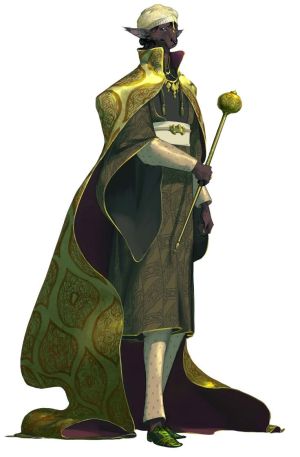
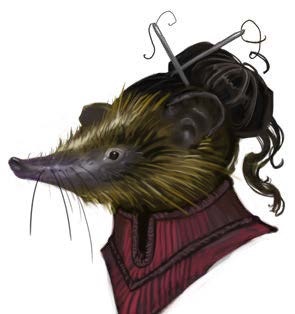
Dalila Bhotphtha (NG female fey-touched beastkin human baker) is a fixture of Hoba Dukuza, as immediately recognizable as King Webhekiz himself. As the owner of Bhotphtha Bakery, Dalila feeds nearly 300 customers a day, working alongside her numerous children and grandchildren. While Dalila often likes to credit her bakery skill to “all the extra taste buds” as she flicks her long tongue in a light snap, the truth is she’s the recipient of literal centuries of baking experience, which she has, in turn, spent a lifetime passing on to her offspring. Catching sight of one of the fairly distinctive members of Dalila’s family (even by the unique and colorful standards of Bhopan) as they trundle through the streets of Hoba Dukuza pushing a pastry cart often leads to cheers and lines of neighborhood children eagerly following the courier to see what lucky person is receiving the delivery. These processions, noisy and rowdy affairs affectionately referred to as “chattering pies” by the citizenry, are always joyous and happen with great regularity.
King Webhekiz (LN male fey-touched human aristocrat) didn’t expect his rule to be notable, or even particularly exciting. As the hereditary monarch of a land hidden from the world and largely frozen in time, Webhekiz had every reason to believe his rule, like his mother’s before him and her father before that, would proceed as every other monarch’s rule had for over 400 years. It wasn’t to be. When agents from the Pathfinder Society arrived on Bhopan’s shores, Webhekiz became embroiled in a whirlwind of political intrigue and ancient magic for which he was woefully unprepared. The prophecies about the sealed vault beneath Eternal Bloom and the ancient monster that destroyed the old Bhopanese empire all came true at once, with explorers from the Pathfinder Society heralding misfortune for the second time in Bhopan’s history.
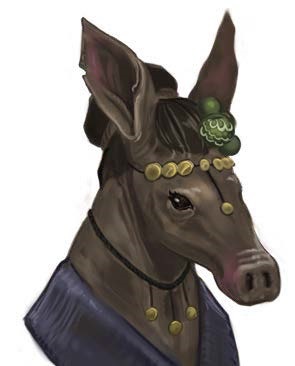
Fortunately—if any of the circumstances thrust upon Webhekiz can be characterized as “fortunate”—the Pathfinders with whom he was required to deal were notably more considerate and conscientious of their position as outsiders than the expedition led by Selmius Foster. Unfortunately, Webhekiz had a dissenter in his court: his vizier and most trusted confidant, Lelzeshin. The vizier believed Webhekiz to be incompetent and undeserving of his throne, so Lelzeshin manipulated the visiting Pathfinders into removing a powerful artifact from its safety in the palace vaults, drawing the attention of the Thorned Monarch.
Having survived the turmoil of a betrayal, a giant monster attack, and the first diplomatic encounter with people from the outside world in several centuries, Webhekiz was forced to reevaluate his own comportment and his plans for the future of Bhopan. No longer able to simply watch the seasons pass in stately order while hosting dances and mediating minor disputes, Webhekiz recognizes he needs to take on a stronger role as a leader and begin making critical plans for Bhopan’s future. To that end, Webhekiz organized several critical projects, including building ships and training sailors as the first steps to forming a Bhopanese navy. Webhekiz realizes that for the safety of his people, Bhopan can no longer hide from the world but must instead find a way to become a part of it once more, on the terms and initiative of the Bhopanese people.
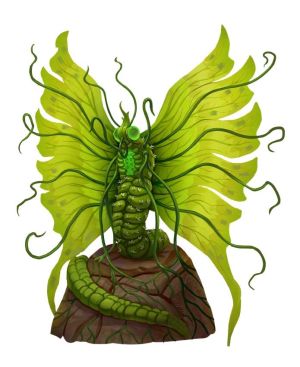
Tannik Vey (LG female fey-touched human scout) is widely considered the most competent person in Bhopan, particularly since the passing of the former vizier. Though nearly 70 years old, Tannik is still the best shot with a crossbow of the entire Greenwatch, a fact she continues to prove every year during Hoba Dukuza’s spring competitions. Tannik’s legend began when she joined the Greenwatch at the age of 15, one of the youngest members ever accepted by the organization. Tannik attempted to enlist following an invasion by a local biloko clan but was refused by the then-captain of the Greenwatchers. Undeterred, Tannik immediately challenged the captain to a marksmanship contest. The terms were simple: if Tannik won the contest, the captain would serve as her lieutenant until such time as Tannik no longer had need of his services; if Tannik lost, she would donate her crossbow to the Greenwatch and forswear ever joining the organization. The captain assumed Tannik’s inevitable failure would be a harsh lesson for the young people considering joining the Greenwatch, but his plan backfired.
During the competition, Tannik placed a bolt in the exact center of the target with every single shot. The captain, though exceptionally skilled with a shortbow and capable of firing arrows with incredible speed, couldn’t compete with the young woman’s uncanny accuracy. After they each fired 10 shots, the outcome was clear: Tannik was the superior archer. Tannik was awarded the grand prize for the competition, a purse of 50 silver pieces, which she immediately donated to the Greenwatch before taking her place as captain. Over the next few years, the former captain came to accept all had played out for the betterment of Bhopan. Tannik was one of the finest leaders the Greenwatch had ever had, and the captain-turned-lieutenant retired early with a full pension, content in the knowledge Bhopan was as safe as the Greenwatch could possibly make it.
Tannik’s hands are as steady as ever and her eyes still as keen. With King Webhekiz creating a new royal navy, Tannik realized age didn’t quiet her ambitions. She requested the opportunity to lead the new naval force, spending her free time learning to sail and steer a ship along with the other prospective naval officers. Tannik knows being the best shooter in Bhopan isn’t the same as being the best shooter, and she hopes to spend her remaining years seeing what challenges and opportunities the world beyond the outer forest might hold for her.
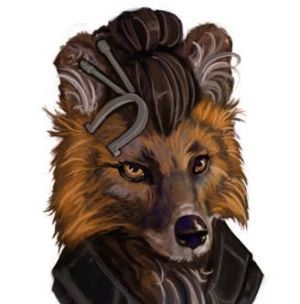
The current guard captain, Toffith (LN male fey-touched beastkin warrior) was appointed by King Webhekiz after Lelzeshin’s betrayal. Toffith is well-respected by both the guards serving under him and the people of Bhopan. Earnest, kind, and perhaps overly serious, Toffith is generally quite competent, though he has a tendency toward bumbling in the presence of his Greenwatch counterpart, Tannik Vey (page 124). Tannik is the kind of legendary hero Toffith hopes to become, and the young man can’t help but feel starstruck in the presence of his role model. For her part, Tannik does what she can to mentor Toffith and treat him as an equal, relying on her iron will and incomparable poker face to ensure that Toffith’s confidence isn’t destroyed by an ill-timed smile the guard captain might take as mockery.
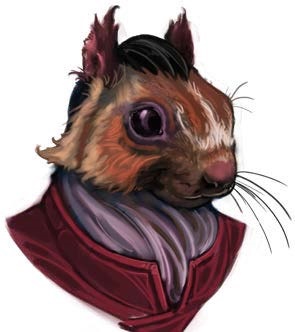
Vizier Lelzeshin (LE male fey-touched human advisor) was always more competent and intelligent than the king he served, which irked Lelzeshin terribly. Why should he, a man gifted with unusual magic and skill, serve at the whims of an unambitious king whose greatest accomplishment was being born into the right family? Eventually, Lelzeshin’s ambition left him vulnerable to the psychic corruptions of Qxal the Thorned Monarch (CE ancient fey tyrant), who used Lelzeshin to manipulate both King Webhekiz and an expeditionary team sent to Bhopan by the Pathfinder Society. While Webhekiz survived the chaotic events and the Pathfinders ultimately put an end to the Thorned Monarch, Lelzeshin was slain while trying to claim the artifact known as the Perennial Crown for himself. Lelzeshin’s unfulfilled ambitions, fueled by the Thorned Monarch’s manipulations, wouldn’t allow him to rest easy, even in death. Now a ghost wandering the hallways of Eternal Bloom, and occasionally spotted by children lurking in the shadows of Hoba Dukuza’s gardens and amphitheaters, Lelzeshin lingers, forever determined to claim the throne of Bhopan for himself and eternally unable to do so.
Even as a ghost, Lelzeshin still keeps secrets that might ultimately prove dangerous to Bhopan. In life, Lelzeshin was corrupted by the psychic whispers of the Thorned Monarch. In death, Lelzeshin hears those whispers more clearly than ever. They speak to him of opportunities yet to come, of a life that might be his once more, and of sweet revenge that will assuredly be claimed if only he lingers, if only he waits, if only he opens the door when Qxal knocks once more. Whenever the vizier’s ghost passes a mirror, he sees within its depths not a reflection of his surroundings, but rather a burning portal to a place of darkness and unending torment, where a giant creature rests in a cocoon of thorns and hellfire, pulsing with a dark life yet to be reborn.
Familiar Faces
Players might have encountered Qxal, King Webhekiz, and the traitorous Vizier Lelzeshin during the Pathfinder Society organized play campaign, with players from around the world deciding the ultimate fate of Bhopan’s encounter with the Pathfinders. This book assumes that the players managed to spare an enchanted King Webhekiz, killed Vizier Lelzeshin after the latter revealed his true colors, and slew the fey tyrant Qxal (though none can be sure if the fey creature will return again, as so many powerful fey often do). To experience the events listed above for yourself, visit pathfindersociety.club and join the community![1]